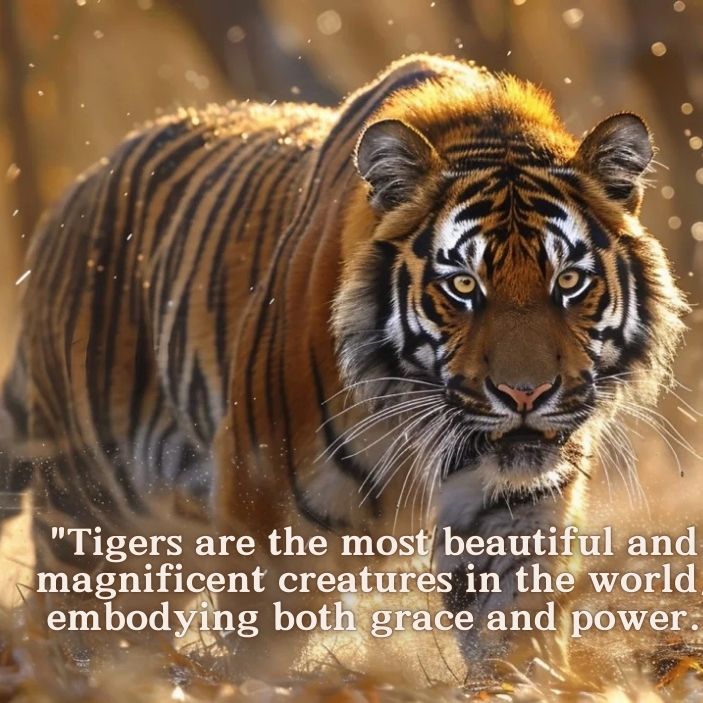
“Tigers: Icons of Strength and Beauty”
Tigers, the largest members of the cat family, are majestic creatures that captivate the imagination. Their striking orange coats, adorned with black stripes, not only provide them with camouflage in their natural habitats but also symbolize the beauty and power of wildlife. Found primarily in Asia, these magnificent animals inhabit diverse ecosystems, from dense jungles to open grasslands. One of the most fascinating aspects of tigers is their adaptability. They are solitary hunters, relying on their keen senses and powerful physiques to stalk and ambush prey. Their diet mainly consists of large ungulates, such as deer and wild boar, making them vital to maintaining the balance in their ecosystems. However, tigers face numerous challenges, including habitat loss and poaching, which have significantly reduced their populations.
- Physical Characteristics
The tiger (Panthera tigris) is the largest of the big cats, with adults weighing between 220 and 660 pounds and measuring up to 10 feet in length, including their tail. Their fur, typically a vibrant orange with dark stripes, not only serves as a striking visual feature but also provides essential camouflage in their natural habitats, which range from dense jungles to grasslands. Each tiger’s stripe pattern is unique, much like a human fingerprint, allowing researchers to identify individuals in the wild.
- Behavior and Habitat
Tigers are solitary animals, preferring to hunt and live alone rather than in groups. This behavior highlights their strength as apex predators. They are primarily nocturnal, using their keen senses of sight and hearing to stalk prey under the cover of darkness. Their diet consists mainly of large ungulates, such as deer and wild boar, but they are also known to take on smaller animals when necessary.
Tigers inhabit a variety of ecosystems across Asia, from the tropical forests of India and Southeast Asia to the cold, snowy landscapes of Siberia. Unfortunately, their habitat is under severe threat from deforestation, human encroachment, and climate change, leading to significant declines in their populations.
- Cultural Significance
Beyond their physical attributes, tigers hold immense cultural significance in various societies. In many Asian cultures, they are seen as symbols of power and bravery. They appear in folklore, mythology, and art, often representing strength and protection. For instance, in Chinese culture, the tiger is one of the 12 zodiac animals, embodying qualities of strength, bravery, and competitiveness.
Tigers have also become cultural icons in modern media, featuring prominently in films, books, and advertisements. Their imagery often evokes feelings of awe and respect, reinforcing their status as majestic creatures of the wild.
- Conservation Challenges
Despite their status as icons of strength and beauty, tigers face numerous threats. Habitat loss, driven by human activities such as logging and agricultural expansion, has drastically reduced their living spaces. Additionally, poaching for their fur, bones, and other body parts continues to pose a significant risk. The illegal wildlife trade remains a major challenge, fueled by demand in traditional medicine and luxury goods.
Conservation efforts are crucial to ensure the survival of tigers in the wild. Organizations worldwide are working to protect their habitats, implement anti-poaching measures, and raise awareness about the importance of preserving these magnificent animals. National parks and wildlife reserves serve as sanctuaries, providing a safe haven where tigers can thrive and reproduce.
- A Call to Action
Tigers are more than just beautiful creatures; they are vital components of their ecosystems. As apex predators, they help maintain the balance of prey populations, ensuring the health of their habitats. By appreciating tigers as icons of strength and beauty, we also recognize the urgent need to protect them.
Supporting conservation initiatives, advocating for sustainable practices, and educating others about the plight of tigers can contribute to their preservation. Together, we can ensure that future generations will continue to be inspired by these majestic animals, both in the wild and in our collective imagination. Through awareness and action, we can help safeguard the legacy of tigers as enduring symbols of strength and beauty in the natural world.
- In conclusion
Panthera tigris, or the tiger, stands as a powerful symbol of strength and beauty in the animal kingdom. As apex predators, tigers play a crucial role in maintaining ecological balance. However, they face significant threats from habitat loss and poaching. Conservation efforts are vital to ensure their survival and preserve their majestic presence in the wild. By fostering awareness and supporting initiatives aimed at protecting tigers, we can help secure a future where these magnificent creatures continue to roam our planet, inspiring awe and respect for generations to come.















